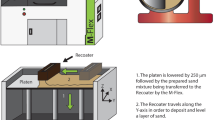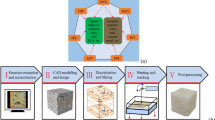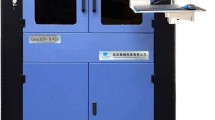Abstract
Additive manufacturing technology, or 3D printing, with silica sand has enabled the manufacture of porous rock analogues for the use in experimental studies of geomechanical properties of reservoir rocks. The accurate modelling of the fluid flow phenomena within a reservoir and improving the performance of hydrocarbon recovery require an understanding of physical and chemical interactions of the reservoir fluids and the rock matrix. Therefore, for the 3D printed samples to serve as rock analogues, flow properties have to be equivalent to the petrophysical properties of their natural counterparts, such as Berea sandstone. In this study, sandstones that were 3D printed with silica sand and Poly-Furfuryl alcohol (PFA) binder, were used to investigate interactions between porous media with different fluids. Wettability preference of 3D printed samples was characterized through contact angle measurements, as well as co-current and counter-current spontaneous imbibition experiments. Results indicated that 3D printed sandstones had mixed-wet characteristics due to the high preference of silica grains for polar fluids and the affinity PFA binder to the oleic phase. Printing configurations including binder saturation were found to greatly influence the wettability preference of the 3D printed analogue rocks as higher PFA concentrations resulted in more strongly oil-wet preferences. Efforts to optimize the printing process and challenges to control the wettability preferences of the 3D printed samples are also highlighted.










Similar content being viewed by others
References
Abdallah, W., Buckley, J.S., Carnegie, A., Edwards, J., Herold, B., Fordham, E., Graue, A., Habashy, T., Seleznev, N., Signer, C., Hussain, H., Montaron, B., Ziauddin, M.: Fundamentals of wettability. Oilf. Rev. (2007). https://doi.org/10.6028/nbs.ir.78-1463
Akin, S., East, M., Kovscek, A.R., Stanford, U., Members, S.P.E.: Imbibition Studies of Low-Permeability Porous Media. In: SPE Western Regional Meeting, pp. 1–11. Anchorage, Alaska (1999)
Amott, E.: Observations relating to the wettability of porous rock. Pet. Trans. AIME 216, 156–162 (1958)
Anderson, W.G.: Wettability literature survey-part 2: wettability measurement. Pet. Technol. 38(12), 1–371 (1986)
Ardila, N.: Hydraulic Properties Characterization of 3D Printed Sandstone Analogues (Master’s Thesis). Retrieved from education and research archive (2018). https://doi.org/10.7939/R3X34N686
Blunt, M.J., Bijeljic, B., Dong, H., Gharbi, O., Iglauer, S., Mostaghimi, P., Paluszny, A., Pentland, C.: Advances in water resources pore-scale imaging and modelling. Adv. Water Resour. 51, 197–216 (2013). https://doi.org/10.1016/j.advwatres.2012.03.003
Bobek, J.E., Mattax, C.C., Denekas, M.O.: Reservoir rock wettability-its significance and evaluation. J. Pet. Technol. 213, 155–160 (1959)
Buckley, J.S., Liu, Y., Xie, X., Morrow, N.R.: Asphaltenes and crude oil wetting—the effect of oil composition. SPE J. 2, 107–119 (1997)
Buckley, J.S., Liu, Y., Monsterleet, S., Recovery, P.: Mechanisms of wetting alteration by crude oils. SPE J. 30, 54–61 (1998)
Bultreys, T., Boever, W.De, Cnudde, V.: Earth-science reviews imaging and image-based fluid transport modeling at the pore scale in geological materials: a practical introduction to the current state-of-the-art. Earth Sci. Rev. 155, 93–128 (2016). https://doi.org/10.1016/j.earscirev.2016.02.001
Cai, M.: Rock mass characterization and rock property variability considerations for tunnel and cavern design. Rock Mech. Rock Eng. (2011). https://doi.org/10.1007/s00603-011-0138-5
Cassie, A.B.: Contact angles. Discuss. Faraday Soc. 3, 11–16 (1948)
Choura, M., Belgacem, N.M., Gandini, A.: Acid-catalyzed polycondensation of furfuryl alcohol: mechanisms of chromophore formation and cross-linking. Macromolecules 29, 3839–3850 (1996). https://doi.org/10.1021/ma951522f
Cortes, F., Montoya, T., Acevedo, S.: Nanoparticles of silica and its impact 6, 91–106 (2016)
Cuiec, L.: Rock/crude-oil interactions and wettability: an attempt to understand their interrelation. In: SPE Annual Technical Conference and Exhibition (1984). https://doi.org/10.2118/13211-MS
Denekas, M.O., Mattax, C.C., Davis, G.T.: Effects of crude oil components on rock wettability. In: AIChE- SPE Joint Symposium. Kansas city, MO, 216, pp. 330–333 (1960)
Deng, Y., Xu, L., Lu, H., Wang, H., Shi, Y.: Direct measurement of the contact angle of water droplet on quartz in a reservoir rock with atomic force microscopy. Chem. Eng. Sci. 177, 445–454 (2018). https://doi.org/10.1016/j.ces.2017.12.002
Donaldson, E.C., Alam, W. (eds.): Wettability. In: Wettability, Chap. 1, pp. 1–55. Gulf Publishing Company, Houston (2008)
Falode, O., Manuel, E.: Wettability effects on capillary pressure, relative permeability, and irredcucible saturation using porous plate. J. Pet. Eng. 2014, 1–12 (2014). https://doi.org/10.1155/2014/465418
Gaefke, C.B., Botelho, E.C., Ferreira, N.G., Rezende, M.C.: Effect of furfuryl alcohol addition on the cure of furfuryl alcohol resin used in the glassy carbon manufacture. J. Appl. Polym. Sci. (2007). https://doi.org/10.1002/app.26938
Gahrooei, R., Ghazanfari, M.H., Malekabadi, F.K.: Wettability alteration of reservoir rocks to gas wetting condition: a comparative study. Can. J. Chem. Eng. 96, 997–1004 (2018). https://doi.org/10.1002/cjce.23023
Gerami, A., Mostaghimi, P., Armstrong, R.T., Zamani, A., Ebrahimi, M.: A microfluidic framework for studying relative permeability in coal international journal of coal geology a micro fluidic framework for studying relative permeability in coal. Int. J. Coal Geol. 159, 183–193 (2016). https://doi.org/10.1016/j.coal.2016.04.002
Gill, D.E., Corthe, R., Leite, M.H.: Determining the minimal number of specimens for laboratory testing of rock properties. 78, 29–51 (2005). https://doi.org/10.1016/j.enggeo.2004.10.005
Gomez, J.: Mechanical Properties Characterization of 3D Printed Sandstone Analogues (Master’s Thesis). Retrieved from education and research archive (2018). https://doi.org/10.7939/R31V5BV4Z
Gomez, J.S., Ardila, N., Chalaturnyk, R.J., Zambrano-Narvaez, G.: Reservoir geomechanical properties characterization of 3D printed sandstone. In: Sixth Biot Conference on Poromechanics, pp. 1–9 (2017)
Grate, J.W., Dehoff, K.J., Warner, M.G., Pittman, J.W., Wietsma, T.W., Zhang, C., Oostrom, M.: Correlation of oil–water and air–water contact angles of diverse silanized surfaces and relationship to fluid interfacial tensions. Langmuir 28, 7182–7188 (2012). https://doi.org/10.1021/la204322k
Hui, M., Blunt, M.J.: Effects of wettability on three-phase flow in porous media. J. Phys. Chem. B. 104, 3833–3845 (2000). https://doi.org/10.1021/jp9933222
Ishutov, S.: 3D printing porous proxies as a new tool for laboratory and numerical analyses of sedimentary rocks (Doctoral dissertation). Retrieved from https://lib.dr.iastate.edu/etd (2017)
Ishutov, S., Hasiuk, F.J., Harding, C., Gray, J.N.: Special section: interpretation 3D visualization 3D printing sandstone porosity models. Interpretation. 3, 49–61 (2015)
Ishutov, S., Hasiuk, F.J., Fullmer, S.M., Buono, A.S., Gray, J.N., Harding, C.: Resurrection of a reservoir sandstone from tomographic data using three-dimensional printing. Am. Assoc. Pet. Geol. Bull. 101, 1425–1443 (2017). https://doi.org/10.1306/11111616038
Javaheri, A., Habibi, A., Dehghanpour, H., Wood, J.M.: Journal of Petroleum Science and Engineering Imbibition oil recovery from tight rocks with dual-wettability behavior. J. Pet. Sci. Eng. 167, 180–191 (2018). https://doi.org/10.1016/j.petrol.2018.01.046
Lan, Q., Dehghanpour, H., Wood, J., Sanei, H.: Wettability of the montney tight gas formation. In: SPE Unconventional Resources Conference (2015)
Li, G., Chen, X., Huang, Y.: Contact angle determined by spontaneous imbibition in porous media: experiment and theory. J. Dispers. Sci. Technol. 36, 772–777 (2015). https://doi.org/10.1080/01932691.2014.921627
Longeron, D., Hammervold, W.L., Skjaeveland, S.: Capillary Pressure and Wettability Measurements Using Micropore Membrane Technique. In: SPE International meeting on petroleum engineering held in Beijing (1995)
Ma, N.R.M.S., Zhang, X.Z.X., Ma, S., Zhou, X., Zhang, X.: Characterization of wettability from spontaneous imbibition measurements 45th annual technical meeting of the petroleum society of CIM (1994). https://doi.org/10.2118/94-47
Martinez, M.J., Yoon, H., Dewers, T., Kucala, A., Chojnicki, K.: 3D Printing and digital rock physics for geomaterials. Geol. Soc. Am. 49(6) (2015). https://doi.org/10.1130/abs/2017AM-306918
McKillip, W.J.: Chemistry of furan polymers. Adhes. Renew. Resour. (1989). https://doi.org/10.1021/bk-1989-0385.ch029
Morrow, N.R.: Capillary pressure correlations for uniformly wetted porous media. J. Can. Pet. Technol. 15(04), 49–69 (1976). https://doi.org/10.2118/76-04-05
Morrow, N.R.: Wettability and its effect on oil recovery. J. Pet. Technol. 42, 1–476 (1990). https://doi.org/10.2118/21621-PA
Mugele, F., Siretanu, I., Kumar, N., Bera, B., Wang, L., Ruiter, D., Maestro, A.: Insights from ion adsorption and contact-angle alteration at mineral surfaces for low-salinity waterflooding. SPE J. 21, 1–204 (2016)
Osinga, S., Zambrano-Narvaez, G., Chalaturnyk, R.: Study of geomechanical properties of 3D printed sandstone analogue. Am. Rock Mech. Assoc. 49, 15–547 (2015)
Peters, E.J.: Advanced Petrophysics: Volume 2: Dispersion, Interfacial Phenomena/Wettability, Capillarity/Capillary Pressure, Relative Permeability, pp. 43–61. Live Oak Book Company (2012)
Primkulov, B., Chalaturnyk, J., Chalaturnyk, R., Narvaez, G.Z.: 3D printed sandstone strength: curing of furfuryl alcohol resin-based sandstones. 3D Print. Addit. Manuf. 4, 149–155 (2017). https://doi.org/10.1089/3dp.2017.0032
Ruffolo, R.M., Shakoor, A.: Variability of unconfined compressive strength in relation to number of test samples. Eng. Geol. 108, 16–23 (2009). https://doi.org/10.1016/j.enggeo.2009.05.011
Schmitt, C.R.: Polyfurfuryl alcohol resins. Polym. Plast. Technol. Eng. 3, 121–158 (1974). https://doi.org/10.1080/03602557408545025
Seyyedi, M., Sohrabi, M., Farzaneh, A.: Investigation of rock wettability alteration by carbonated water through contact angle measurements. Energy Fuels (2015). https://doi.org/10.1021/acs.energyfuels.5b01069
Shouxiang, M., Morrow, N. R., Zhang, X.: Generalized scaling of spontaneous imbibition data for strongly water-wet systems. J. Pet. Sci. Eng. 4105, 165–178 (1997)
Song, L., Ning, Z.: The surface wettability of brine in a tight oil reservoir. Pet. Sci. Technol. (2018). https://doi.org/10.1080/10916466.2018.1427109
Strombom, E.H.: Simple, simpler, simplest: spontaneous pattern formation in a commonplace system. Am. J. Phys. (2014). https://doi.org/10.1119/1.4709384
Su, W., Liu, Y., Pi, J., Chai, R., Li, C., Wang, Y.: Effect of water salinity and rock components on wettability alteration during low-salinity water flooding in carbonate rocks. Arab. J. Geosci. 11, 260 (2018)
Swain, P.S., Lipowsky, R.: Contact angles on heterogeneous surfaces: a new look at Cassie’s and Wenzel’s laws. Langmuir 14(23), 6772–6780 (1998)
Treiber, L.E., Archer, D.L., Owens, L.L.: Laboratory evaluation of the wettability of fifty oil-producing reservoirs. Soc. Pet. Eng. J. 12, 531–540 (1972)
Unsal, E., Mason, G., Morrow, N.R., Ruth, D.W.: Co-current and counter-current imbibition in independent tubes of non-axisymmetric geometry. J. Colloid Interface Sci. 306, 105–117 (2007). https://doi.org/10.1016/j.jcis.2006.10.042
Vargas-alfredo, N., Reinecke, H., Gallardo, A., Rodríguez-hernández, J.: Fabrication of 3D printed objects with controlled surface chemistry and topography. Eur. Polym. J. 98, 21–27 (2018). https://doi.org/10.1016/j.eurpolymj.2017.10.033
Wei, M., Bowman, R., Wilson, J.L., Morrow, N.R.: Wetting Properties and stability of siliane-treated glass exposed to water, air and oil. J. Colloid Interface Sci. 157, 154–159 (1993)
Wenzel, R.N.: Resistance of solid surfaces to wetting by water. Ind. Eng. Chem. 28(8), 988–994 (1936)
Yang, S.: Fundamentals of petrophysics, pp. 181–231. Springer (2017). https://doi.org/10.1007/978-3-662-55029-8
Yassin, M.R., Dehghanpour, H., Wood, J., Lan, Q.: A theory for relative permeability of unconventional rocks with dual-wettability pore network. In: Unconventional resources technology conference, pp. 1–11 (2016)
Yassin, M.R., Begum, M., Dehghanpour, H.: Organic shale wettability and its relationship to other petrophysical properties: a duvernay case study. Int. J. Coal Geol. 169, 74–91 (2017). https://doi.org/10.1016/j.coal.2016.11.015
Yu, L., Stavanger, U., Evje, S., Kleppe, H., Kårstad, T., Stavanger, U., Fjelde, I., Stavanger, U.: Analysis of the wettability alteration process during seawater imbibition into preferentially oil-wet chalk cores. In: SPE Symposium on Improved Oil Recovery, 20–23 April, Tulsa, Oklahoma, USA (2008). https://doi.org/10.2118/113304-MS
Yung, K.C., Wang, W.J., Xiao, T.Y., Choy, H.S., Mo, X.Y., Cai, Z.X., Wang, W.J., Xiao, T.Y., Choy, H.S., Mo, X.Y., Zhang, S.S., Cai, Z.X.: Laser polishing of additive manufactured CoCr components forcontrolling their wettability characteristics. Surf. Coat. Technol. (2018). https://doi.org/10.1016/j.surfcoat.2018.07.030
Zhao, B., Macminn, C.W., Juanes, R.: Wettability control on multiphase flow in patterned microfluidics. Proc. Natl. Acad. Sci. (2016). https://doi.org/10.1073/pnas.1603387113
Acknowledgements
The authors wish to acknowledge Energi Simulation Research Consortia in Reservoir Geomechanics for their financial support to the Reservoir Geomechanics Research Group (RG)2 at the University of Alberta. Also, special recognition to Dr. Alireza Rangriz Shokri (RG)2 research staff that contributed to this work.
Author information
Authors and Affiliations
Corresponding author
Rights and permissions
About this article
Cite this article
Ardila, N., Zambrano-Narvaez, G. & Chalaturnyk, R.J. Wettability Measurements on 3D Printed Sandstone Analogues and Its Implications for Fluid Transport Phenomena. Transp Porous Med 129, 521–539 (2019). https://doi.org/10.1007/s11242-018-1176-1
Received:
Accepted:
Published:
Issue Date:
DOI: https://doi.org/10.1007/s11242-018-1176-1




